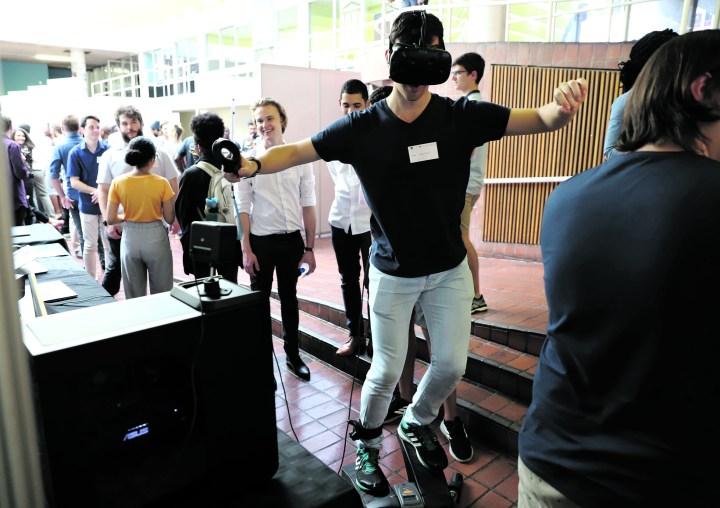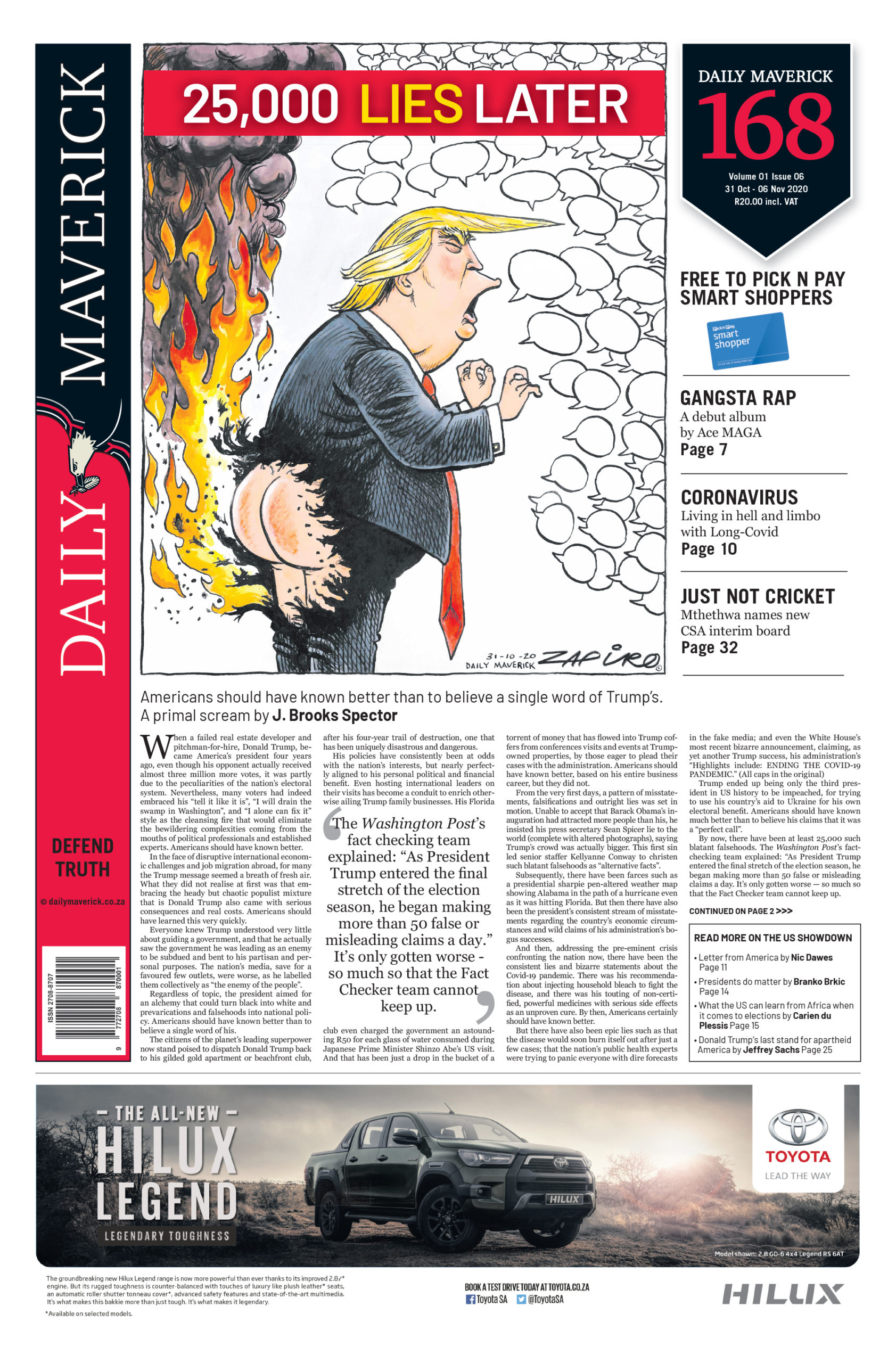Daily Maverick 168
Varsities leap into the future

Higher education was changing anyway, but Covid-19 added steroids.
First published in Daily Maverick 168
Confronted with Covid-19, universities had to adapt or die. They closed their doors, and traditional face-to-face models of teaching and learning were abandoned as large investments were made in online education. And while this re-emphasised inequality and the vast digital divide, it also opened doors to reimagine the future of higher education.
The CEO of Universities South Africa (USAf), Professor Ahmed Bawa, says that while universities will return to contact classes, they will rely heavily on “blended learning”, a combination of traditional methods and online instruction.
“There may be fewer large classroom engagements and more small group tutorials and discussion sessions. This will probably improve the quality of teaching and learning,” says Bawa.
Blended learning provides opportunities to democratise higher education by making it more affordable. As outlined in a USAf paper on reimagining sustainable futures for universities, blended learning could help cut costs by limiting the need for students to travel to campus or live in university accommodation. For working professionals, blended learning — which happens mostly online with contact teaching organised in block sessions — is ideal.
Foregrounded by the #FeesMustFall movement, in recent years conversations surrounding access have been crucial.
The shift to remote learning at the onset of the pandemic laid bare many of the inequalities between students and between universities. Bawa says: “While some universities were able to rapidly shift to emergency remote learning through the use of technology, others found this very difficult. Some universities found that their systems were not yet sufficiently developed to make the switch. More importantly, hundreds of thousands of students simply did not have devices for learning and sufficient connectivity.”
More than 30% of students at Nelson Mandela University (NMU), for example, did not have suitable devices and/or connectivity. To mitigate this, laptops were couriered to students in need, and they also received monthly data bundles.
“The Covid-19 pandemic, therefore, fast-tracked the digital transformation within universities, Mandela included,” says NMU spokesperson Zandile Mbabela.
And digital transformation is blossoming in higher education. Wits University’s DigitalCampus, opened in 2015, is an example. “The primary purpose … was to bring world-class learning experiences to those who do not have access to face-to-face education opportunities and simultaneously take the university short courses into a fully online environment, embracing the dramatic changes in education at the time,” says Gavin Olivier, senior partner and managing executive of DigitalCampus.

DigitalCampus is a public-private partnership between LRMG, a business operating in the digital learning space, and the university. As the name suggests, all teaching and learning is done online.
“Assignments are submitted digitally each week, assessed and feedback provided to students and finally there is an online examination,” says Olivier. Accredited short courses are typically targeted at working professionals looking to upskill.
A similar collaboration exists between the University of Cape Town and GetSmarter. It was launched in 2008 and hosts courses from such universities as Yale, Harvard, the Saïd Business School in Oxford and the London School of Economics.
“The massive change brought about by the Covid pandemic has certainly accelerated the online learning market,” says Olivier. He predicts more universities will gravitate to digital as a primary means of delivering learning.
“Sure, there are some things that can’t be done only online but with virtual and augmented reality fast growing in the market, things will continue to change and so the need for face-to-face is reducing.”
Blended learning is “probably the future”, he says, because social engagement is still vital.
“We live in a massively divided society with many folks not having primary access to devices and reliable internet to learn online and so the design of solutions needs to take cognisance of that. Issues of accessibility and scalability are key to the success of digital campuses of the future.”
Delivering online learning, particularly at scale, is dependent on several factors. Not only are access to a reliable device and a reliable internet connection essential, so is appropriate content.
“When we went into lockdown many institutions weren’t prepared and did not have their learning content on a digital format and so scrambled to get it converted into a format that enabled a meaningful and engaging learning experience fit for purpose,” says Olivier. “Simply copying a set of slides or documents into a PDF version and publishing via a learning system does not make it online.”
Higher education is also embracing the fourth industrial revolution (4IR). The University of Johannesburg (UJ) is an example. Vice-Chancellor Tshilidzi Marwala sits as deputy chair of the Presidential Commission on 4IR and the university has introduced teaching using futuristic techniques.
It launched an online advanced diploma in real estate that uses gamification, 3-D renderings and simulations to make course content more interactive. As students move through the gamified course, the consequences of their decisions are immediately clear.
Ground-breaking work is also being done in the realm of cancer diagnosis. Professor Qing-Guo Wang from UJ’s Institute for Intelligent Systems is using artificial intelligence (AI) to provide accurate cancer diagnoses for patients in remote areas where expert medical care may be scarce.
“For months, Professor Wang and his team — comprising experts in the fields of theoretical and experimental physics and computer science — have been collecting open data on 20,000 breast cancer cases from [Charlotte Maxeke] Hospital’s archives,” a UJ statement says.
“They are digitally uploading this data to their unique AI model, a software platform that is becoming increasingly ‘intelligent’ as more and more information is added to it. The result is an affordable and accurate diagnostic system that will be made widely available in health institutions across the country.”
The UJ School of Accounting has introduced 4IR methodologies to prepare students for the changing world of work. It is the first university in the country to adopt Xero Learn, a cloud-based accounting software teaching platform that allows teachers and students to come to grips with cloud software.
USAf has suggested that the higher education sector needs a strategy on the development of 4IR. “Through these technologies, immersive and personalised education can be provided online at scale. These will not only improve the student experience, quality of education and the online experience, but also lower the costs of higher education provision,” USAf wrote in a study.
Another future-ready institute is the Hasso Plattner School of Design Thinking (d-school) at UCT, which is using design thinking to help students come up with sustainable solutions to some of the world’s problems.
Richard Perez, the school’s founding director, says design thinking gives students the opportunity to develop their creative confidence and obtain skills that enable them to collaborate in multidisciplinary teams.
“By exposing students to the approaches and mindset of seeing the world through the lens of a designer, we aim to enhance our graduate attributes such as creativity, complex problem solving and co-creation — all critical skills needed for the future of work,” he says.
Over the past four years, about 5,000 students from across Africa, ranging from school children to professionals, have attended the school’s programmes. Similar design schools operate at Potsdam University in Germany and Stanford University in the US.
Design thinking is an innovative mindset that changes the way people look at solving real-world problems.
Usually, when people solve problems they are inclined to jump to solutions. But with design thinking, one interrogates the problem from the perspective of the end-user. This leads to not only a better understanding of the problem or challenge but also more effective responses that are based in reality and lived experiences. Design thinking can be seen in products such as an electric toothbrush or in concepts such as Airbnb. It’s even being used to come up with sustainable low-cost housing solutions for the poor.
According to Bawa, USAf is engaged in conversations on how to transform higher learning.
“The teaching and learning strategy group at USAf has this as one of its priorities,” he says. “[It] is engaged in understanding what we can learn from this period but also to understand how the increased use of technology might contribute to improving quality, broadening access, improving success rates, and so on.
“It is an exciting time. We are also looking at developing a national shared-services platform that could be used by all 26 universities as a platform to offer courses in a blended fashion.” DM168
This story was edited post-publication to remove quote attribution to Yazeed Kamaldien who we referred to as spokesperson for UCT d-school. The school does not have a spokesperson and the information Kamaldien shared was contextual and for background.

















 Become an Insider
Become an Insider
Comments - Please login in order to comment.